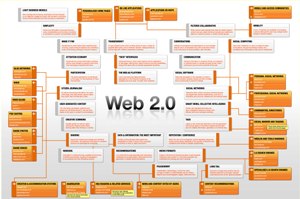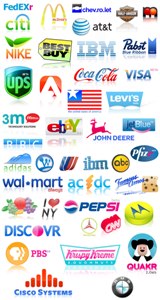
The Web 2.0 is the representation of the evolution from traditional applications to Web applications focused on the end user. The Web 2.0 is an attitude and not just a technology.
Web 2.0 is the transition that has occurred from traditional applications to applications that operate via the website focused on the end user. These are applications that generate collaboration and service to replace desktop applications.
This is a stage that has defined new projects on the Internet and is concerned about providing better solutions for the end user. Many claim that we have reinvented what was the Internet, others speak of bubbles and investment, but the reality is that the natural evolution of the medium really has proposed things more interesting as we look at the daily notes or current links that collect in exploring. And that is where the web started, we were in an environment static HTML pages with little suffering updates and had no interaction with the user.
But to understand where it comes from the term Web 2.0, we must go back to the time when Dale Dougherty of O'Reilly Media used this term in a conference that shared a brainstorming alongside Craig Cline of Media-Live. In the event there was talk of revival and development of the site.
Constantly emerging new applications and sites with striking features, that was the pattern for the Web 2.0 conference that began in 2004 and now takes place annually in San Francisco, with additional events using the trademark in other countries.
The Web 2.0 with examples
Understanding the evolution that has come with Web 2.0 can be done by example, with projects. We can compare web services that make clear the progression toward Web 2.0 with a new way of doing things:

The Web 2.0 does not mean precisely that there is a recipe for all our web applications into this scheme. However, there are several technologies that are currently used and that we should consider more carefully in search of further evolve next to the site.
In chat initial Web Conference spoke of the principles which had 2.0 Web applications:
Web 2.0 is the transition that has occurred from traditional applications to applications that operate via the website focused on the end user. These are applications that generate collaboration and service to replace desktop applications.
This is a stage that has defined new projects on the Internet and is concerned about providing better solutions for the end user. Many claim that we have reinvented what was the Internet, others speak of bubbles and investment, but the reality is that the natural evolution of the medium really has proposed things more interesting as we look at the daily notes or current links that collect in exploring. And that is where the web started, we were in an environment static HTML pages with little suffering updates and had no interaction with the user.
But to understand where it comes from the term Web 2.0, we must go back to the time when Dale Dougherty of O'Reilly Media used this term in a conference that shared a brainstorming alongside Craig Cline of Media-Live. In the event there was talk of revival and development of the site.
Constantly emerging new applications and sites with striking features, that was the pattern for the Web 2.0 conference that began in 2004 and now takes place annually in San Francisco, with additional events using the trademark in other countries.
The Web 2.0 with examples
Understanding the evolution that has come with Web 2.0 can be done by example, with projects. We can compare web services that make clear the progression toward Web 2.0 with a new way of doing things:

- Web 1.0> Web 2.0
- Doubleclick -> Google AdSense (Advertising Services)
- Ofoto -> Flickr (Communities photo)
- Akamai -> BitTorrent (Distribution of contents)
- Mp3.com -> Napster (music downloads)
- Britannica Online -> Wikipedia (Encyclopedias)
- Personal Sites -> Blogs (Personal Pages)
- Speculation with domains -> Search Engine Optimization SEO
- Depth -> Cost per click
- CMSs -> Wikis (Administrators contents)
- Categories / Directories -> Tags
The Web 2.0 does not mean precisely that there is a recipe for all our web applications into this scheme. However, there are several technologies that are currently used and that we should consider more carefully in search of further evolve next to the site.
In chat initial Web Conference spoke of the principles which had 2.0 Web applications:
- The web is the platform
- The information is what moves to the Internet
- Effects of the network moved by an architecture of participation.
- Innovation comes from features distributed by independent developers.
- The end of the circle making software because we have services in perpetual beta


1 comment:
Natural SEO generates traffic for your website because of the list rankings that your sites achieve when search results are displayed. The results are naturally listed, and are not paid for; they are call organic results, as opposed to the results shown from pay per click advertising.
Post a Comment